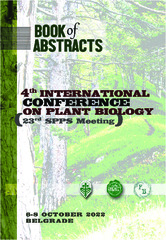Приказ основних података о документу
Phenotyping of camelina (Camelina sativa (L.) Crantz) response to drought stress at germination stage
| dc.creator | Marjanović-Jeromela, Ana | |
| dc.creator | Čanak, Petar | |
| dc.creator | Kondić-Špika, Ankica | |
| dc.creator | Rajković, Dragana | |
| dc.creator | Jovičić, Dušica | |
| dc.creator | Vujošević, Bojana | |
| dc.creator | Miladinović, Dragana | |
| dc.creator | Zanetti, Federica | |
| dc.date.accessioned | 2022-10-04T10:37:09Z | |
| dc.date.available | 2022-10-04T10:37:09Z | |
| dc.date.issued | 2022 | |
| dc.identifier.isbn | 978-86-912591-6-7 | |
| dc.identifier.uri | http://fiver.ifvcns.rs/handle/123456789/3100 | |
| dc.description.abstract | Camelina sativa (L.) Crantz, is a self-pollinated, annual oilseed from the Brassicaceae family, which is gaining interest worldwide due to its frost, heat, and drought tolerance. The aim of this study was to evaluate camelina germination under osmotic stress, and to identify critical soil moisture levels for successful germination establishment. A germination test was set up in controlled conditions, comparing six winter and six spring genotypes with differing seed sizes (ranging from 0.88 to 1.83 g/1000-seeds) under increasing levels of osmotic stress (0, −0.4, −0.8, −1.2, −1.4, −1.6 MPa) that was produced with polyethylene glycol (PEG). The results showed good tolerance of all camelina genotypes to drought at the germination stage. Plants remained unaffected at mild level of osmotic stress (−0.4 MPa) having no significant decrease in germination percentage compared with the control. Even at −1.2 MPa, examined genotypes still had high germination (75%). Significant differences in germination were observed be-tween biotypes, where spring biotypes performed better than winter ones. Shoot and radicle lengths were significantly diminished by imposed osmotic stress, but shoot growth seemed more impacted. In general, spring biotypes had longer shoots and radicles than winter ones. Seed size played a role in the response of camelina to drought, but it depended on biotype and stress level imposed. Camelina confirmed to withstand high levels of drought stress at germination and could be considered as more suitable oil crop than oilseed rape on marginal lands, or areas with irregular precipitation pattern. | sr |
| dc.language.iso | en | sr |
| dc.publisher | Belgrade : Serbian Plant Physiology Society | sr |
| dc.publisher | Belgrade : University of Belgrade, Institute for Biological Research „Siniša Stanković“ | sr |
| dc.publisher | Belgrade : University of Belgrade, Faculty of Biology | sr |
| dc.relation | APV 142-451-2609/2021-01/02: Potencijal ulja od lanika i šafranike kao funkcionalnog dodatka u hrani za kućne ljubimce, financed by the Provincial Secretariat for Higher Education and Scientific Research, AP Vojvodina | sr |
| dc.relation | info:eu-repo/grantAgreement/MESTD/inst-2020/200032/RS// | sr |
| dc.relation | Climate Crops - Centre of Excellence for Innovations in Breeding of Climate-Resilient Crops, Institute of Field and Vegetable Crops | |
| dc.rights | openAccess | sr |
| dc.rights.uri | https://creativecommons.org/licenses/by/4.0/ | |
| dc.source | Book of Abstracts, 4th International Conference on Plant Biology (23rd SPPS Meeting), 6-8 October 2022, Belgrade | sr |
| dc.subject | osmotic stress | sr |
| dc.subject | shoot length | sr |
| dc.subject | radicle length | sr |
| dc.subject | seed size | sr |
| dc.subject | camelina | sr |
| dc.subject | germination | sr |
| dc.subject | phenotyping | sr |
| dc.title | Phenotyping of camelina (Camelina sativa (L.) Crantz) response to drought stress at germination stage | sr |
| dc.type | conferenceObject | sr |
| dc.rights.license | BY | sr |
| dc.citation.epage | 119 | |
| dc.citation.spage | 119 | |
| dc.identifier.fulltext | http://fiver.ifvcns.rs/bitstream/id/8701/AMJ.pdf | |
| dc.identifier.rcub | https://hdl.handle.net/21.15107/rcub_fiver_3100 | |
| dc.type.version | publishedVersion | sr |


